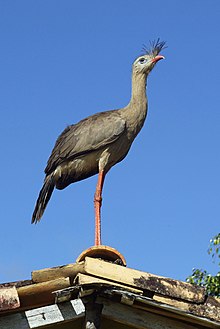Rotfußseriema
| Rotfußseriema | ||||||||||
|---|---|---|---|---|---|---|---|---|---|---|

Rotfußseriema ( Cariama cristata ) |
||||||||||
| Systematics | ||||||||||
|
||||||||||
| Scientific name of the genus | ||||||||||
| Cariama | ||||||||||
| Brisson , 1760 | ||||||||||
| Scientific name of the species | ||||||||||
| Cariama cristata | ||||||||||
| ( Linnaeus , 1766) |
The red-footed seriema ( Cariama cristata ) is a species of bird found in central South America.
distribution
It is common in central and eastern Brazil (north to the states of Tocantins and Piauí ), in eastern Bolivia , Paraguay , Uruguay and in central, northern Argentina (south to the north of the province of La Pampa ).
description
The Rotfußseriema reaches a body length of 75 to 90 cm with a weight of 1.5 kg. The beak is red, the light yellow eyes contrast with the blue, featherless skin around the eyes. The upper eyelid has black eyelashes. The long legs are salmon-colored. The flight feathers are banded in black and white. The tail is long and broad; its feathers have white tips. Young birds show dark brown stripes on their head, neck and back. The bill and legs are gray.
From the black-footed seriema ( Chunga burmeisteri ) that occurs sympathetically with it in the south of the distribution area , the only other series-haired species, the red-footed seriema can be easily distinguished by its striking, upright tufts of feathers on the forehead.
voice
The birds mainly call at dusk, sometimes at other times of the day, even during the hot midday hours. Your reputation is a loud whine that something like kyupkyup-kyupkyup-kyupkyup-kyup-kypo-kyo kyo kyo ... sounds. It sometimes sounds like a slightly hysterical, gradually fading chatter and sometimes lasts for several minutes. Often the birds call with their heads thrown back from an elevated position.
Way of life
The Rotfußseriema occurs in open forests, in thorn-shrub savannas, savannas and on pastures, in the south of Brazil and in Uruguay in hilly grasslands near forests and in the typical biotopes Caatinga , Cerrado and Gran Chaco . The altitude distribution ranges from almost sea level to 2000 meters in Argentina and in southeastern Brazil. Rotfußseriema are mostly resident birds and do not migrate, with the exception of a few local trains in the Gran Chaco. They feed mainly on arthropods ; this includes grasshoppers, beetles, ants, insect larvae and spiders but also smaller vertebrates such as amphibians, small lizards and snakes, chicks and young birds, as well as eggs and small rodents. Maize, other grass seeds, fruits and tree sap are also taken in depending on the season. Usually the animals look for their food alone or in pairs, during the breeding season also in small family groups. They look for their food on the ground or in low vegetation. Larger food animals are grabbed with the beak and beaten to the ground to kill them or held with the feet and torn with the beak.
The breeding season varies depending on the occurrence. In northeastern Brazil, the breeding season is from February to July, in central Brazil from September to January and in Argentina from November to December. The birds breed individually. The nest is built in the forks of small trees, usually one to five meters above the ground. It consists of branches and twigs and is lined with leaves, clay or cow dung. The two to three eggs per clutch are white with yellow-brown or light purple markings. The incubation period is 24 to 30 days. Especially the female breeds. The chicks are brownish, dark brown on the back and light brown and speckled on the belly side. Their hair-like head feathers are strikingly long. They leave the nest after about 14 days and are fed by their parents for about a month (captivity observations). They get their adult plumage when they are around 4 to 5 months old.
Danger
The Rotfußseriema is classified by the IUCN as Least Concern. It is widespread, but not common anywhere. In some areas it is hunted, in others it is protected by farmers as a beneficial insect that devours rodents and snakes. In the southern part of the range the species suffers from urban sprawl and the destruction of its habitat, in the northern part it can expand its habitat as a result of man-made deforestation .
literature
- LP Gonzaga: Red-legged Seriema (Cariama cristata). In: Josep del Hoyo , Andrew Elliott, David Christie: Handbook of the Birds of the World . Volume 3: Hoatzin To Auks. Lynx Edicions 2001, ISBN 84-87334-20-2 .
Web links
- Cariama cristata in the endangered Red List species the IUCN 2012. Posted by: BirdLife International, 2012. Accessed August 15, 2013.
- BirdLife International: Species Factsheet - Red-legged Seriema ( Cariama cristata ) . Retrieved August 15, 2013.
- xeno-canto: Sound recordings - Red-legged Seriema ( Cariama cristata )

